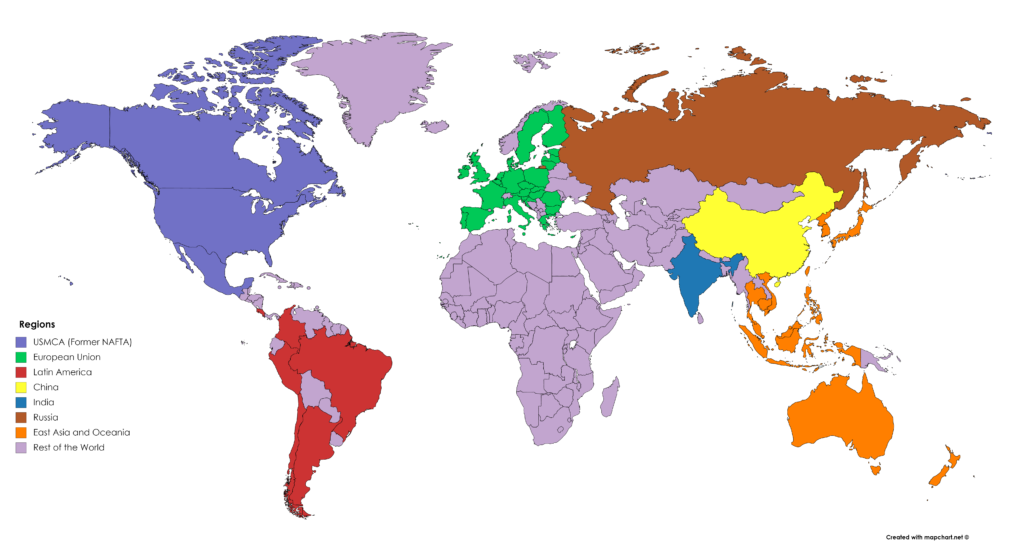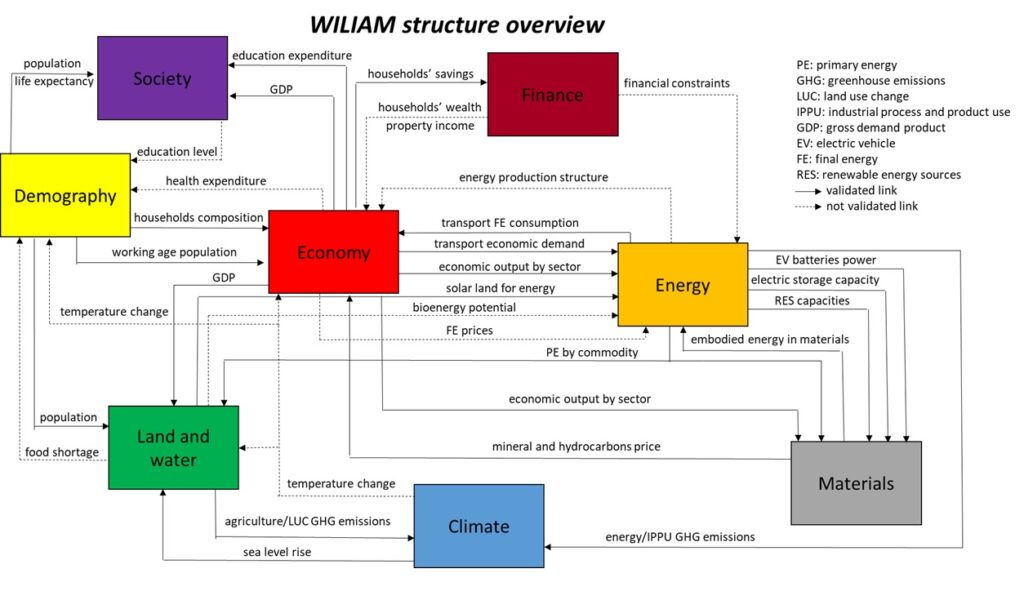Integrated assessment model
The WILIAM (“Within limits”) Integrated Assessment Model (IAM), developed in the scope of LOCOMOTION, is a multi-regional model consisting of nine world regions, one of which is the EU-27 (at country level). WILIAM starts to run in 2005 and typically runs until 2060 where net decarbonisation targets should be met, although the simulation horizon may be extended to 20100.
The WILIAM model is partly built on the existing MEDEAS model that was developed in the context of the EU-funded MEDEAS project. For the study of the highly complex interactions between humans and their environment, the project draws on different techniques and methods, such as System Dynamics (SD) modelling with Vensim software, Input-Output Analysis (IOA), Energy Return On Investment (EROI) calculations, Life Cycle Analysis (LCA), land and carbon footprinting, microsimulation, and many others.
Integrated assessment model
Targeted at: Scientists, modelling experts.
Available from: The latest versions of the model in Vensim is available in Github. The Python version is also available in Github.
Format: The final IAM is available in Vensim and Python.
License: MIT open source license.
Support: Deliverable 9.3 available from this website, and the e-Handbook.
For specific questions concerning the model, please contact info.wiliam@uva.es
Model structure
WILIAM model is structured in eight integrated modules of earth and human systems: (1) demography, (2) society, (3) economy, (4) finance, (5) energy, (6) materials, (7) land and water, and (8) climate. This structure allows for flexibly testing, improving and expanding each module without impairing the robustness of the models as a whole:
- Demography: allows to develop comprehensive scenarios of regional population evolution (including household’s heterogeneity) feeding economy, given exogenous assumptions.
- Society: includes indicators of inequality (Gini), development (HDI) and a stylized education submodule.
- Economy: The economy is represented by a dynamic econometric model covering 35 regions, with detailed representation of consumption (including 60 households’ types), production (based on input-output tables of 62 sectors), government (including collection of taxes + public expenditures), investment, labour, international trade and financial dimensions. The economy module is integrated with the rest of the modules: changes in the physical bottom-up models (e.g. energy transformation, transport, material extraction) affects the economic model (e.g. production structure, production/consumption/investment decisions) and vice versa.
- Finance: allows a better understanding of the constraints in the economic and energy system due to financial assets and public and private debt.
- Energy: The full energy supply-chain is represented with high detail through the main refinery, transformation and supply processes. The variability of renewables is considered by keeping track of sub-annual time scale effects on annual energy balances depending on the current power system setup of build-up of generation capacities and flexibility capacities (demand-side management, storage, sector coupling, hydrogen and synthetic fuels). The computation of the EROI of the full system considers the EROI and material requirements of green technologies, which feedbacks the energy demand. Techno-sustainable potentials of renewables are included considering biophysical, geographical, natural resources and EROI constraints. Passenger transport are modelled bottom-up and includes a detailed representation of 11 transport modes, 10 power trains and a portfolio of behavioural policies.
- Materials: The module includes fossil fuels, uranium and the main base metals which are fully integrated with energy and economy modules. The material requirements for key green technologies are also assessed in a bottom-up way for solar, wind and electric batteries.
- Land and water: The land-use module including human food, energy and climate interactions, thus allowing endogenizing land-based renewable potentials (solar and bioenergy), considering the agriculture and land related emissions, and the effects of climate change on biophysical variables such as crop yields. The main output of the water module is water availability based on demand, supply and climate change impacts.
- Climate: The module converts emissions coming from the other modules in changes in main climate variables, such as mean temperature change and sea level rise. Climate change impacts on capital stock, labour productivity and crop yields.
Model novelties
Countless Integrated Assessment Models (IAMs) have been developed in the decades since the pioneering World3 model was created in the early 1970s (Meadows et al. 1972). Even though great advances have been made in the field since then, many IAMs, and especially those with greater influence over policy, share a core set of assumptions whose validity is being disputed in the scientific community, leaving scope for improvement.
| Addressed key limitations in the IAM field | WILIAM characteristics |
| An often too simplistic representation of the economic processes | Represents the economy through a dynamic model with detailed representation of consumption (including 60 households’ types in EU), production (based on input-output tables of 62 sectors), government, investment, labor, international trade and financial dimensions |
| Which hampers the representation of interaction of economy with other dimensions |
Captures energy ↔ economy ↔ materials interactions Changes in the physical bottom-up models (e.g. energy transformation, transport, material extraction) affect the economic model (e.g. production structure, production/consumption/investment decisions) and vice versa. Includes the economic climate change impacts |
| Absence of key dimensions | Includes modules for demography, society and materials |
| Assumption of very high energy potentials |
Includes techno-sustainable potentials of renewables considering biophysical, geographical, natural resources and EROI constraints. Includes a land-use module allowing endogenizing land-based renewable potentials (solar and bioenergy). |
| Neglect metabolic implications of future energy investments | Computes the EROI of the full system considering the material requirements of green technologies |
| Address challenges of 100% renevables systems |
Keeps track of sub-annual time-scale effects on annual energy balances depending on the generation and flexibility capacities. Models hydrogen. |
Scenarios and policies
Scenarios are plausible stories or descriptions about how the future, given a set of assumptions, might unfold. They allow us to explore a wide range of ‘What-if’ questions about hypothetical future worlds, backed by quantitative data, and thus make comparisons between different trajectories. This typically includes also the trajectory “business-as-usual”, which implies that all past observed trends continue into the future.
WILIAM model relies on scenarios not to make predictions about the future, but to apply different policies in different plausible contexts and assess their implications. Scenarios are furthermore used to deal with uncertainty as they allow exploring different assumptions and how they play out over time.
In LOCOMOTION, four scenarios have been defined (albeit not fully parametrised), distinguishing between
- Baseline scenario, which represent an interpretation of the continuation of current trends. It is modelled along the lines of the SSP 2 storyline.
- Policy-action scenarios: these storylines include additional or enhanced policy measures, which allow for attaining the goals inherent in the scenario narrative:
| Green Growth | Green Deal | Post-growth | |
| Environmental goals | Prioritized – through markets and innovation | Prioritized – through markets, innovation, regulation, and large public expenditures | Prioritized – through transformation of economy, regulation, production slowdown and behavioural change |
| Socio-economic goals | Not an objective per se, trickle-down (as in baselines) | Specific inclusion policies | Universal social policies |
| Economic goals | Absolute decoupling of economic growth from resource consumption | Absolute decoupling of economic growth from resource consumption | Degrowth of the economy to a level that allow mankind to stay within the biophysical limits of our planet |
More information on the scenario logic used in WILIAM can be found in the e-Handbook.





